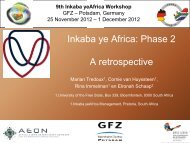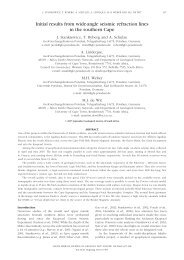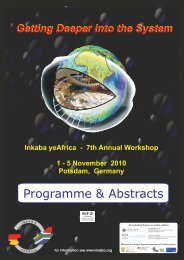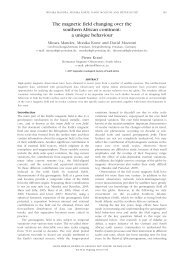South Africa - Inkaba.org
South Africa - Inkaba.org
South Africa - Inkaba.org
You also want an ePaper? Increase the reach of your titles
YUMPU automatically turns print PDFs into web optimized ePapers that Google loves.
Economic benefits of varying maize production strategies<br />
under various seasonal rainfall scenarios<br />
in the Modder River catchment, <strong>South</strong> <strong>Africa</strong><br />
K.M. Nape 1,2 and A.S. Steyn 1<br />
1. Department Soil, Crop and Climate Sciences, University of the Free State, <strong>South</strong> <strong>Africa</strong>,<br />
dr.bean@webmail.co.za<br />
2. Agricultural Research Council – Institute for Soil, Climate and Water, <strong>South</strong> <strong>Africa</strong><br />
ABSTRACT<br />
The Modder River catchment is characterised by high rainfall variability which leads to a mismatch between water<br />
demand by crops and water supply by rainfall. It is understood that farmers aim to employ a farming system that<br />
maximizes production and minimizes risk whilst making a profit. Reducing the risk associated with rainfall<br />
variability could have significant impacts on crop production. The main objective of this study was therefore to<br />
investigate the economic benefits of different maize production strategies using a crop model against the backdrop<br />
of various seasonal rainfall scenarios.<br />
Seasonal rainfall totals were calculated from 1950-1999 for selected quaternary catchments within the Modder<br />
River catchment for two 3-month periods (October, November, December and January, February, March)<br />
comprising the maize growing season. Each 3-month period were subsequently categorized as above-normal (AN),<br />
near-normal (NN) or below-normal (BN). A crop model (APSIM) was used to simulate maize yields under various<br />
management strategies (i.e. choice of cultivar, plant density, planting dates, fertilizer application and weeding<br />
frequency) for all the seasons. The simulated maize yields were analysed in order to determine the economic<br />
benefit of applying different management decisions.<br />
During above-normal rainfall seasons (AN-AN) the best practices involved a plant density of 21 000 plants/ha, a<br />
fertiliser application of 50 kg/ha N and weeding twice for a crop planted during 16-30 November. This would lead<br />
to a 50% probability of obtaining a profit of R2 319/ha. During dry seasons (BN-BN) the most productive<br />
combination included a plant density of 12 000 plants/ha, fertiliser application of 35 kg/ha N and weeding twice for<br />
a crop planted during 1-15 November. This would lead to a 50% probability of obtaining a mere profit of R497/ha.<br />
The results indicate that management strategies guided by seasonal rainfall forecasts could aid in achieving<br />
sustainable rainfed maize production.<br />
KEYWORDS: maize production strategies, seasonal rainfall scenarios; crop model<br />
59









